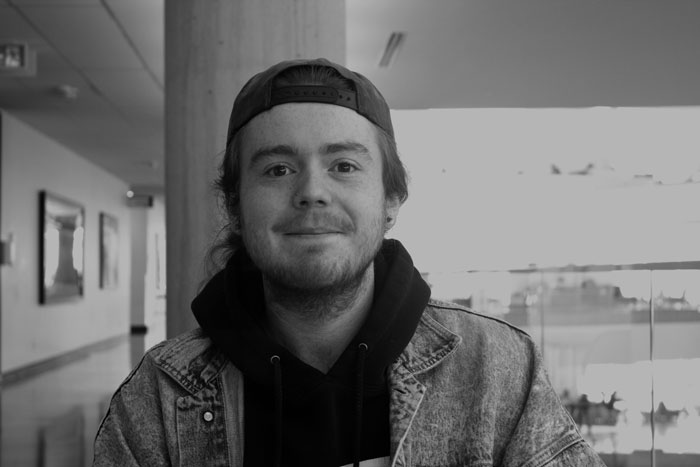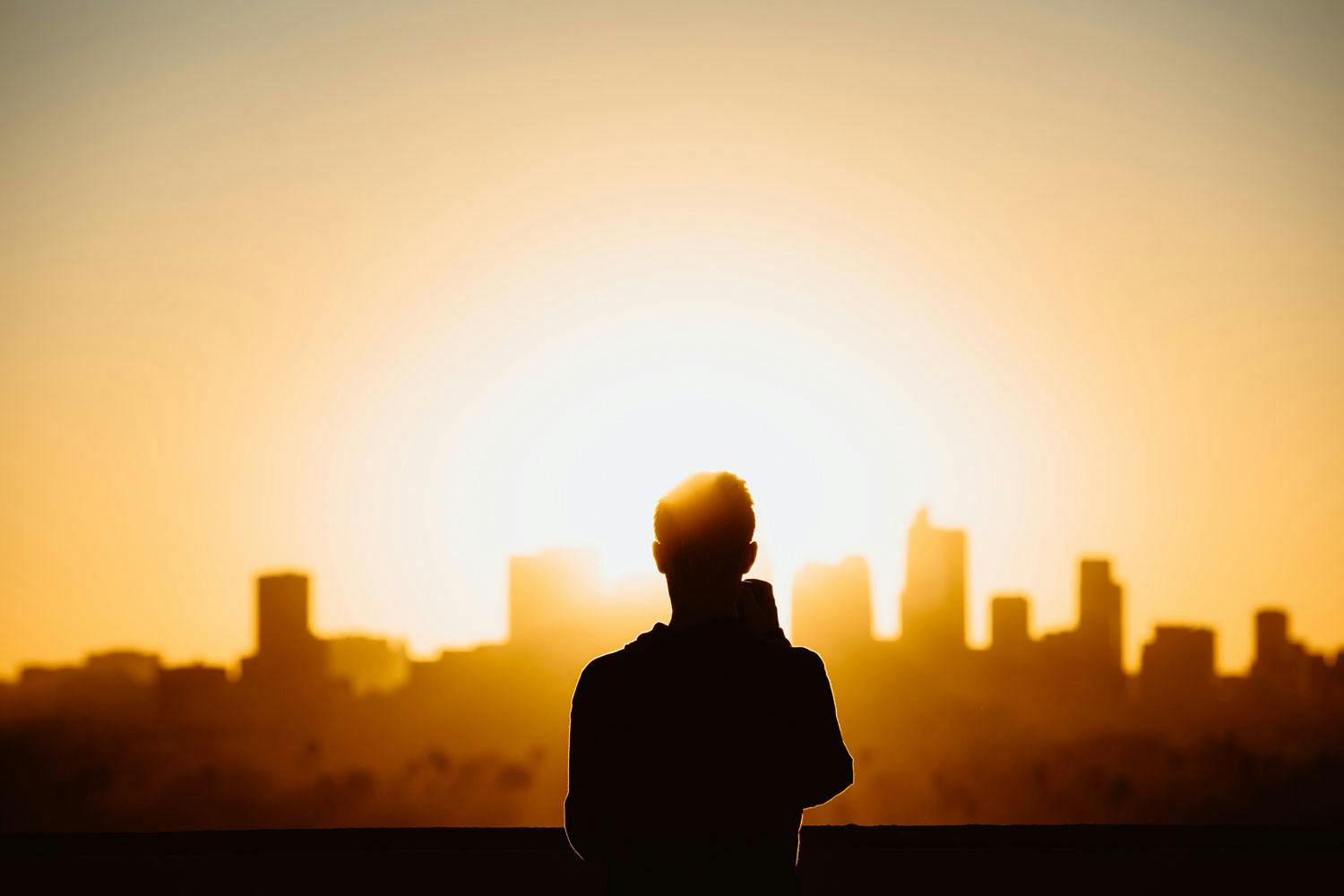When You Can’t Afford to Keep Cool
A student’s heat wave experience showed him the costs of the climate disaster.
Jack Farrell, 25, was born and grew up in Edmonton, AB. His parents divorced when he was very young. Since then, Jack has only ever lived with his mother. As a child, he played sports such as hockey, baseball, and soccer for a long time. When he turned 18 and finished high school, he started trying to figure out who he wanted to be.
“It took me a little bit of time before I decided, ‘I want to go to university,’” says Jack, who describes himself as an introspective and quiet person. He would always “learn by watching other people do things and copy them.” Jack is interested in listening to other people’s stories. That’s partially why he pursued a degree in journalism at MacEwan University, which he was completing when he was interviewed for the Climate Disaster Project.
Jack lives alone with his cat in a “pass-through area” near downtown Edmonton. He was working as a delivery person at a pizza shop when 2021’s Western North America heat wave hit Canada. This first-person narrative was shared as part of the Climate Disaster Project. Details about the project follow this story.
I always like to check the weather. I like to know what kind of weather is coming and what I need to dress for each day. I checked the weather a lot. I remember checking it, and then I saw in a week and a half that it was going to be 38°C or something in Edmonton.
It was shocking to me because I don’t think I’ve seen anything warmer than that in my 24 years here. I thought it was a mistake. I tweeted one of the weather people with a screenshot of the weather. I was like, “Please tell me this is fake, and this is not happening.”
He replied really quickly and said, “Nope, we’re going to have a very historic heat wave and best to start preparing now.”

I remember the first day that the heat wave really set in. It was 36°. I remember going outside and I thought, “This isn’t going to be too bad.” I was outside for not even five minutes and I was like, “Never mind, this is going to be really bad.”
I started sweating immediately. It was awful. Everything just looked hot. It felt like I was wearing sunglasses, but I wasn’t. Everything looked orange. Everything looked glistening, and simmering. I was afraid to touch anything because I knew it was just a million degrees. Every possible surface was just ready to be a stovetop.
I don’t have AC in my apartment, so it was already extremely hot in here. It’s hot in the summer no matter what. When the weather outside is 40°, it’s unbearably hot. It’s so bad. I couldn’t sleep at all. It was just awful. I also don’t understand how my landlord fucking left a note on all of our doors saying to not put air conditioning units in the suites. If you don’t have air conditioning in the building, how do you expect us to live through this?
Everything looked glistening, and simmering. Every possible surface was just ready to be a stovetop.
I don’t have blinds over my windows. I couldn’t afford to buy blinds at the time. I took two bedsheets and I nailed them to the wall over the windows to try and act as blinds but they’re both white bedsheets. They didn’t even really work too well. All it did was make everything dusky inside and it didn’t help with heat whatsoever. Maybe it did, but it sure didn’t feel like it did. It always makes me laugh every time I think about it. I had to have bedsheets hanging over my windows.
I went to work on the first day of the heat wave. I drive a very shitty car. You can’t trust it a lot. During that time, I was having problems with the radiator. It would overheat if it was idling too much. I remember being in an absolute panic. When I was driving to work, I was so worried. If I hit too many red lights, my car was going to overheat. The AC in my car didn’t work well either. So all the windows were down and I was speeding trying to get the air flowing.
I would get to work, and the very first thing I would do is sit in the freezer for 15 minutes before my shift started. I would always get to work early to let myself have like 15 minutes to cool completely down. Every day I looked forward to those 15 minutes in the freezer. It was probably the best part of it all.
After the disaster, I was so excited that I could go outside and not be in such a panic. I rejoiced in seeing that it was only 25° out and not 40. I felt that overwhelming sense of joy you feel when something you’re anxious about is done with. Like when you write an exam, you’re always worried about the exam. As soon as it’s over, everything is great. The world is lovely. I remember the week after the heat wave was over, everything’s so nice. I can go outside and not feel like I’m dying. It was all overwhelming joy at being able to go outside and not just panic.
I guess I really honestly always felt a little bit protected in my northern Alberta bubble. We’ll get the extreme cold, but we’re safe from the extreme heat. It made me realize that protective bubble was not real. It felt so extreme. At the time, I couldn’t think of anything worse. But now, more than a year later, not only have we had worse things happen since, but I know worse things are going to happen here. We’ve watched towns burn down. We’ve watched record-setting heat and cold. It’s event after event after event. I think the heat wave was the first one that I truly lived through that made me just realize the trouble that we’re all in.
There’s a lot of things I just wasn’t prepared for. Financially, I wasn’t prepared to get air conditioning or get what you need to keep yourself really hydrated when you’re in a heat wave like that. While I was out driving around delivering pizza, I couldn’t always just buy cold drinks. You can only bring so many water bottles with you. And the water bottles, they don’t stay cold the whole time. You can put as much ice in them as you want, but they’re going to melt and be hot water in a water bottle again in like an hour or so. I wasn’t prepared for that.
You can put as much ice in bottles as you want, but they’re going to melt and be hot water again in like an hour.
I definitely could have received some monetary help through government. “We’re living through a disaster, here’s financial help to make it through,” kind of help. Whether it be a small amount or gift cards to grocery stores. Here’s 600 bucks. Here you go. That would have made the world of difference to me.
I know that would have made the world of difference to other people as well. Any sort of help that I could have used to keep myself cold. If it was a little more of a significant amount, maybe I could have fixed some things on my car to get the air conditioning to work. That would have been incredible. That would have been so nice.
For real solutions, there needs to be a serious readjustment on what we as individuals do on a day-to-day basis, and what we consume. Everybody’s got to recycle. We’ve already been doing that. We know it’s not what we actually need to do. There needs to be a serious change in the things that we consume. On a scale that’s like, you don’t buy anything that’s been manufactured. You don’t buy clothes or you only buy clothes that have already been made. You thrift everything.
You ask any kind of broke university student, and they’ll show you how it’s done. I live off like $8 a day. I’ll show you how to live and not buy anything. There just needs to be a very serious clampdown on everything. We need to keep doing bigger and bigger things that make bigger and bigger differences. We need to change everything.
This story was created as part of the Climate Disaster Project. Based at the University of Victoria and led by faculty at 12 other post-secondary institutions, the project includes a virtual international class where journalism, social work, and writing students work with people who have lived through climate disasters to share those stories.
Before the students undertake that work, they share their own stories with one another. And now some of those stories are being shared with you, Asparagus readers. It’s the beginning of a decades-long project to create the world’s largest memory vault of climate experiences, where we will follow a perennial pattern of sharing stories, and finding the problems and solutions in them. Because stories create community, and community creates hope. Visit our Climate Disaster Project page to read more student narratives.
